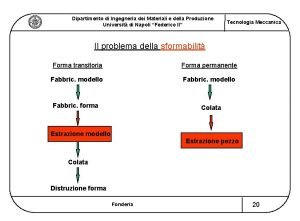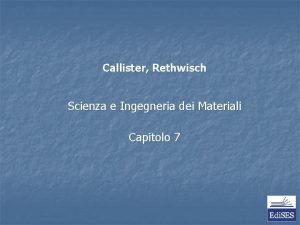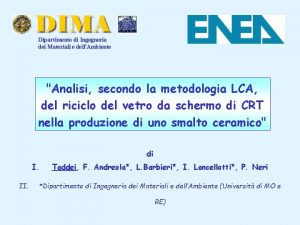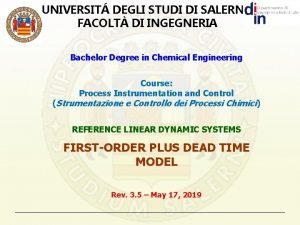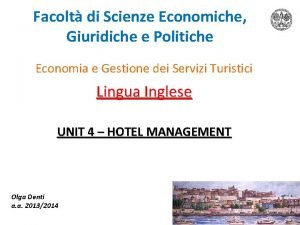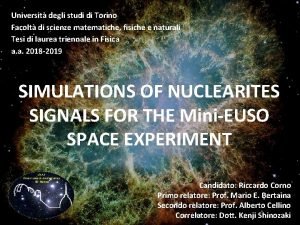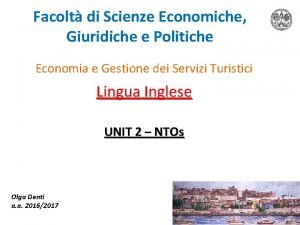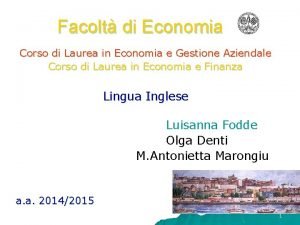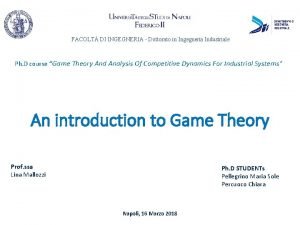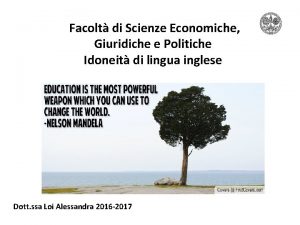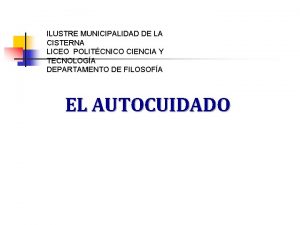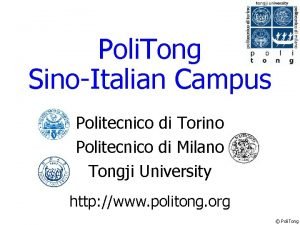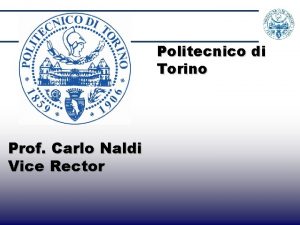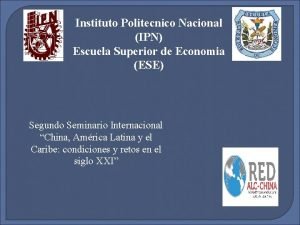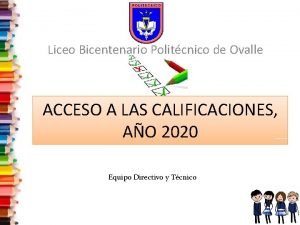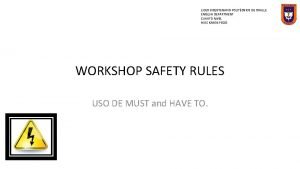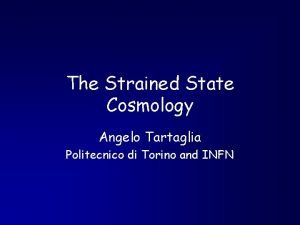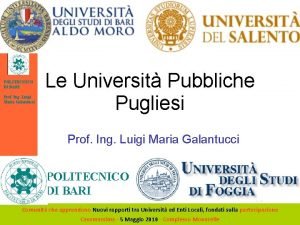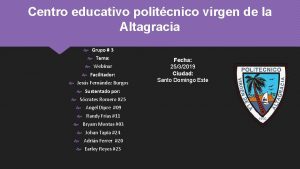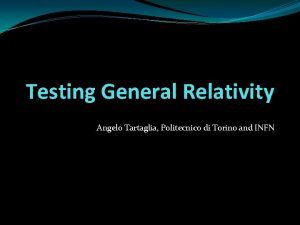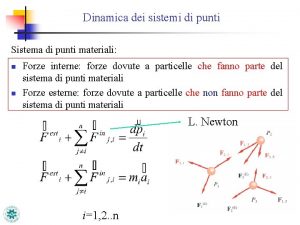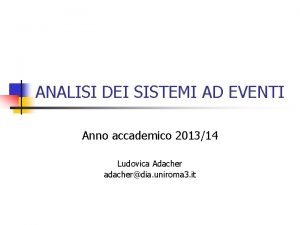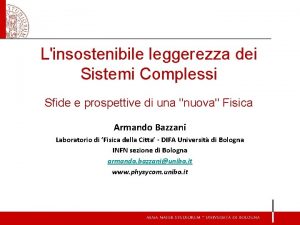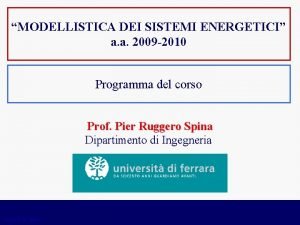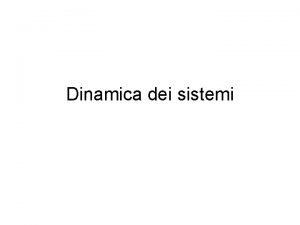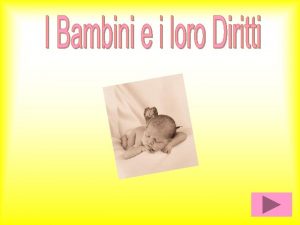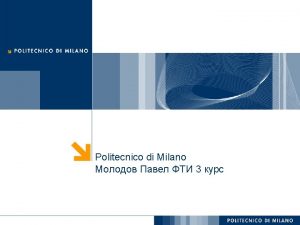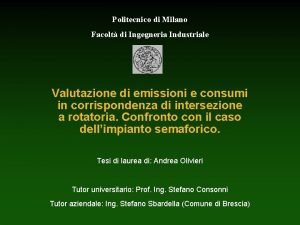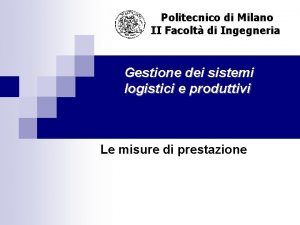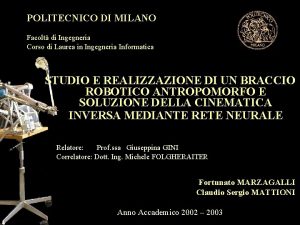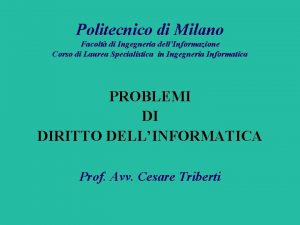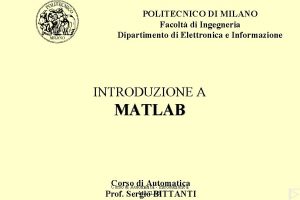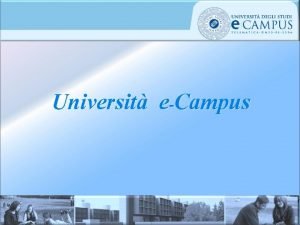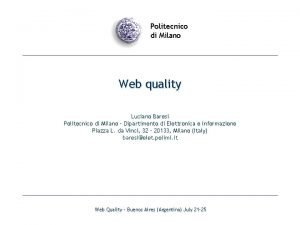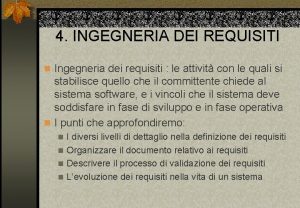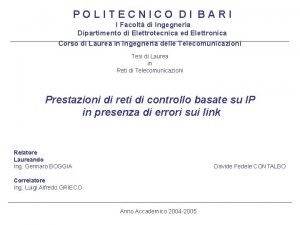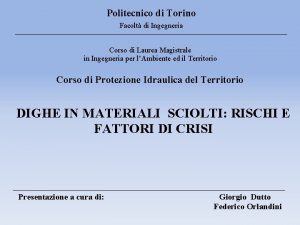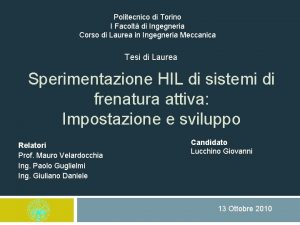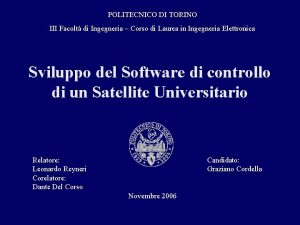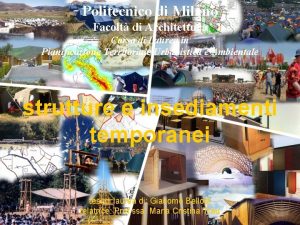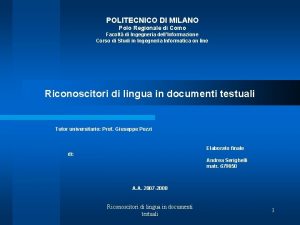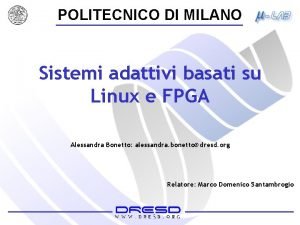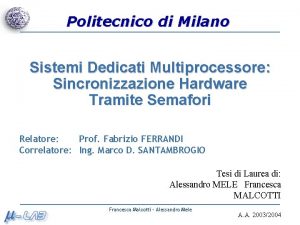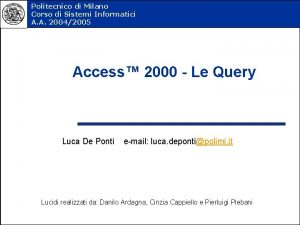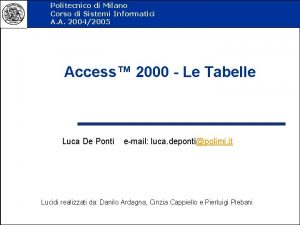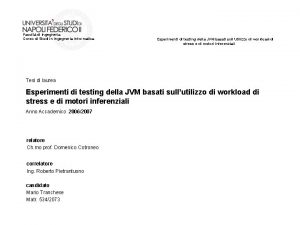POLITECNICO DI MILANO Facolt di Ingegneria dei Sistemi





























- Slides: 29

POLITECNICO DI MILANO Facoltà di Ingegneria dei Sistemi TECHNISCHE UNIVERSITEIT EINDHOVEN Corso di Laurea in Ingegneria Biomedica Faculty of Biomedical Engineering Division of Cardiovascular Biomechanics AN EXPERIMENTAL AND COMPUTATIONAL STUDY OF A NEW ENDOVASCULAR PROSTHESIS FOR THE TREATMENT OF ABDOMINAL AORTIC ANEURYSMS Supervisors: Prof. Gabriele DUBINI Prof. Frans N. Van de VOSSE MSc Thesis: Salvatore Luca FICCO

Aim of the project AIM OF THE PROJECT The study is about the possibility to realize a custom made prosthesis for the endovascular treatment of abdominal aortic aneuryms (AAA) REALIZATION OF A PROTOTYPE It was realized a prototype of the new prostheis afterwards it was tested in vitro by using an experimental set-up. COMPUTATIONAL ANALYSIS Structural analyses were carried out using the Finite Element Method

Pathology PATHOLOGY Aneuryms are permanent and localized dilatation of an artery. The abdominal aorta (the piece of the aorta between the renal arteries and the bifurcation of the femoral arteries) is considered aneurismatic if its diameter is greater than 5 cm. SANE AORTA ANEURYSM

Pathology During the treatment of AAA diagnostic and imaging techniques are very important mainly for two reasons: Ø generally patients do not suffer any disease correlated with the dilatation of the abdominal aorta; Ø the shape of an aneurysm is important in order to be able to operate in an appropriate way.

Pathology Aneurysms show tendency to grow untill wall rupture occurs in one or more sites Common sites of rupture Aneurysm formation and danger of rupture are well illustrated by Laplace’s Law T=Pr Ø r: radius of the vessel Ø T: wall tension necessary to withstand the blood pressure (P) 3 4 1 2 1. Behind the peritoneum 2. In the abdominal space 3. In the duodenum 4. Into the inferior vena cava

Surgical Techniques CURRENT SURGICAL TECHNIQUES ANEURSMECTOMY: It is the substitution of the aneurismatic piece with a vascular prosthesis very invasive operation Technique: (1) Incision (2) Opening and asportation of the thrombus (3) Insertion of the vascular (4) Suture of the aortic prosthesis wall ENDOVASCULAR SURGERY: It consists in the insertion of a stent-graft through one or two small incision(-s) in the femoral artery( -ies). Technique (bifurcated stent): (1) Catheter insertion (2) Stent release

Surgical Techniques DRAWBACKS & COMPLICATIONS ENDOVASCULAR SURGERY Ø Mobilization: prosthesis detaching at one or more attachment sites Ø Endo-tension: transmission of pressure through thrombus or artheroma at the proximal attachment site ØEndo-leaks: four kinds of blood leakages ANEURISMECTOMY Ø General anaesthesia Ø Large incision Ø Hypothermy Ø Damages at the aneurysm necks (due to clamping procedure) Ø Respiratory problems Ø Significant blood and fluid loss

The Endoliner ENDOLINER®: A NEW CONCEPT OF ENDOVASCULAR PROSTHESIS ü The durability of the construction of an Endoliner® is not necessarily a prerequisite. Distinctive characteristics Working mechanism ü Its structure adapts entirely to the aneurysm wall from the proximal neck untill the bifurcation of the femoral arteries Ø As an additional procedure during the treatment of intact aneurysms Ø As an emergency treatment of ruptured aneurysms Occlusion of the collateral arteries and prevention of type II endoleaks Occlusion of leaks through emergency catheterization

The Endoliner POSSIBLE GEOMETRIC CONFIGURATIONS Net Zigzag Spiral

Materials MATERIALS: In order to realize the prototype it was chosen a nickel-titanium alloy showing shape memory behaviour. Solid-solid phase transformation Austenite Martensite (“Hot” shape) (“Cold” shape) Material tests after heat treatment Ø Alloy: Ni. Tinol alloy B 55. 9% Ni, 43. 9% Ti, C e O Ø Load-Unload 0. 9 mm 0. 17 mm Ø Traction to failure 50 mm Ø Sample

The Experimental Analysis THE EXPERIMENTAL SET-UP For the realization of set-up different considerations were taken into account Transparency to visually follow the events occurring in the set-up MRI proof for monitoring events inside the aneurysm Sterility in order to hold “live” aneurysms Variability in lenght for different sizes of aneurysms

The Experimental Analysis TECHNICAL CHARACTERISTICS Modular structure Electric motor Volumetric pump No-return valve Variable resistence Control Resistence Valve Volumetric pump Electric motor

The Experimental Analysis PREPARATION OF AN ANEURYSM MODEL After modelling a generic aneurysm shape by using gypsum powder, it was covered with some layers of latex leaving two small tubes for the insertion of the pressure wires. REALIZATION OF THE PROTOTYPE After the preparation of the aneurysm shape for the heat treatment (500°C per 10 min) the Ni. Ti band was wound around it to procede with the heat training Afterwards water-proof silk was hand sealed all around the structure.

The Experimental Analysis Thus, the prosthesis prototype has a structure reproducing the geometry of the aneurysm model The Endoliner® was than inserted coaxially into the delivery system and wound on itself.

The Experimental Analysis: Pressure Acquisition Pressures By looking were at the acquired pressure in the characteristics middle of the it isaneurismatic possible to observe sac (withthat: and without Endoliner®) in order to study the ability of the prototype to avoid endoleakages and to ®” pressures Ø In the case “with Endoliner preserve the aortic wall. The prototype is not able to preserve the wall from high are a few inferior (1 -2 rate: mm. Hg) Ø Cardiac 1. 25 Hz (75 bpm) pressures Test Ø Sampling: 128 samples period (8 period) Freezing effect on the patient Parameters Ø The insertion of the prototype does not Ø Signal aortic flow: systolic rise time (linear ) = 0. 075 condition s; diastolic decay time cause pressure falls for or peaks (linear) = 0. 225 s; diastolic time: rest of the cycle The Endoliner® can be an effective by-pass usable to contain the rupture RESULTS

The Experimental Analysis: Images By to looking at the it isofpossible to observe that: In order estimate the images unfolding the structure and the geometrical configuration of the prototype images were acquired with a video camera connected to an endoscopic Ø The prototype does notand adhere device coaxially inserted into the Endoliner®. Endoleaks completely to the wall at the formation proximal and distal attachment sites Ø A good unfolding of the prototype structure RESULTS Fixed shot of the middle of the sac Pulling the camera Proximal neck Distal neck

The Computational Study AIM OF THE COMPUTATIONAL ANALYSIS Studying the interaction between the aortic wall and the Nitinol structure Estimating the recovery of the memorized shape Ø Geometrical approximation Limits of the analysis Ø The pre-load due to the blood pressure was not considered • Rhinoceros: to create the models Software • Gambit: to mesh the models • ABAQUS: analysis code. It has been enriched by using a procedure to model the behaviour of shape memory alloys [Auricchio F. , 2002 ]

The Computational Study GEOMETRICAL MODEL Reduced model • Lenght: 15 mm • Ø: 49. 5 mm • s wall: 1. 5 mm • s thrombus: 4 mm Ø Complex geometrical structure Ø Interaction between different materials Ø Long computational times • Ø: 46 mm It is possible to consider only one coil • Pitch: 5 mm • Section: 0. 17 x 0. 9 mm

The Computational Study MECHANICAL PROPERTIES OF THE MATERIALS Ø Coil: the behaviour is described by the Auricchio’s procedure. Young’s moduls (10 GPa, 12 GPa) from the experimental tests. Ø Thrombus: Hyperelastic model Ø Wall: Hyperelastic model Strain Energy Function: Ogden N = 3 Strain Energy Function : Polynomial N = 2 From litterature uniaxial traction test data (executed on biological samples) Average mechanical characteristics generated by ABAQUS Wall Thrombus

The Computational Study BOUNDARY CONDITIONS 1. To take into account the rest of the vessel 2. To avoid rigid body motion 3. To crimp the coil AAA sections constrained along the longitudinal direction AAA lateral surface constrained along the circumferential direction Set of displacements along the radial direction assigned to the nodes of the inner coil surface ANALYSIS STEPS Crimping Releasing “SMA”

The Computational Study MESHING THE MODELS Hexahedral elements (each with 8 nodes) were chosen to mesh all the structures of the model. Therefore the elements were 16607 in all: • 723 for the coil • 12464 for the thrombus (2) • 3420 for the wall (1) 1 2

RESULTS Unfolding Von Misesofstresses the coil

The Computational Study DISCUSSION The higher stress acting on the wall and due to the coil is about 0. 04 MPa It is 10 times less than the stress due to the pre-load only (0. 3 MPa) • Peak stress for an AAA [Fillinger, 2002] = 0. 4 MPa The single coil gives a very small contribute to the risk of rupture Ø The coil does not recover completely its shape, mainly for two reasons: 1. The biomechanical behaviour of the thrombus is very difficult to simulate 2. The single coil cannot develop a force able to deform enough the thrombus Ø The nodal displacements are not elevate: 0. 2 mm ( DSF = 10 ) • They can be comparated to the ones due to the pre-load only (0. 14 mm)

Conclusions & Late Developments CONCLUSIONS The experimental study showed that it is possible to realize a prototype of the Endoliner® and the experimental set-up resulted suitable for those kind of tests. The analysis of the pressures revealed a freezing effect of the Endoliner® that can be useful during the stabilization phase From the computational analysis it came out that a prosthesis like the Endoliner® does not overload the aorta, therefore it can be a good supporting structure for the aneurismatic sac LATE DEVELOPMENTS • Development of different geometries for the prototype • Implementation of complex models for the thrombus without axial simmetry • Tests on biological samples of AAA • Analysis of the behaviour of two or more coils • Construction of an attacching system for the prototype • Different approaches to the computational problem

The End

La Patologia Pochi dati statistici sono sufficienti a sottolineare l’incidenza di questa patologia: Ogni anno negli Stati Uniti sono diagnosticati circa 200. 000 casi di aneurismi aortici addominali 50. 000 -60. 000 di questi pazienti si sottopone ad un intervento chirurgico Il 10% della popolazione maschile manifesta dilatazioni dell’aorta addominale Fra i pazienti che presentano aneurismi aortici rotti 50% 25% Decede in breve Sopravvive Non tempo (prima di sopravvive raggiungere un’Unità di Pronto Intervento) alla chirurgia d’emergenza [Yano, 2000]

La Patologia L’EZIOLOGIA Nonostante i numerosi studi a tal proposito, l’esatta causa che porta all’insorgenza di un aneurisma aortico è tutt’ora sconosciuta. PRINCIPALI FATTORI DI RISCHIO Artereosclerosi ed ipertensione Età Razza Traumi alla parete vasale e infezioni Fattori genetici Fumo Carenza di collagene eo elastina Alterazioni dei sistemi di rilascio di ossigeno e nutrimenti alla parete

La Patologia Le principali tecniche di imaging si differenziano per: qualità, costo, tempi di acquisizione. Quelle maggiormente utilizzate sono: Ø ULTRASUONOGRAFIA Ø AORTOGRAFIA Ø RISONANZA MAGNETICA (MRI) Ø TOMOGRAFIA COMPUTERIZZATA (CT) Ø HELICAL CT § Vantaggi: costo ridotto, non largamente diffusa. § Vantaggi: non invasiva, stima delle dimensioni §buona Vantaggi: identifica disturbi renodell’aneurisma, localizza§vascolari le. Svantaggi: estensioni prossimali dell’aneurisma. e vasi anomali. non adattadiper §§ Vantaggi: non invasiva, tempi acquisizione Vantaggi: assenza di radiazioni, non invasiva. pazienti obesi, poco oggettiva. § Svantaggi: utilizzo di radiazioni, costi. Costi elevati, scarse informazioni § Svantaggi: elevati, invasività, ridotti. Svantaggi: costi elevati, artefatti di movimento, circa l’anatomia§ dell’arteria. tolleranza del paziente. §disponibilità Svantaggi: (SW utilizzo di radiazioni, costidel elevati, e HW), claustrofobia paziente. tecnologia.

Lo Studio Computazionale L’INTERAZIONE DI CONTATTO PLACCA/SPIRA Ø Contatto fra le due superfici gestito da ABAQUS® tramite l’algoritmo master-slave Ø Modello di contatto: soft esponenziale Placca Spira
 Spinte metallostatiche
Spinte metallostatiche Scienza e ingegneria dei materiali callister
Scienza e ingegneria dei materiali callister Ingegneria dei materiali
Ingegneria dei materiali Facolt
Facolt Match the verbs 1-6 with the nouns a-f
Match the verbs 1-6 with the nouns a-f Facolt
Facolt Facolt
Facolt Facolt
Facolt Facolt
Facolt Facolt
Facolt ʃeə
ʃeə Facolt
Facolt Liceo politecnico ciencia y tecnologia
Liceo politecnico ciencia y tecnologia Smart campus poli
Smart campus poli Politecnico di torino rector
Politecnico di torino rector Politecnico economia
Politecnico economia Ovalle.edufacil
Ovalle.edufacil Liceo bicentenario politecnico de ovalle
Liceo bicentenario politecnico de ovalle Politecnico di torni
Politecnico di torni Angelo tartaglia politecnico torino
Angelo tartaglia politecnico torino Logo politecnico di bari
Logo politecnico di bari Politecnico virgen de la altagracia
Politecnico virgen de la altagracia Angelo tartaglia politecnico torino
Angelo tartaglia politecnico torino Dinamica dei sistemi di punti materiali
Dinamica dei sistemi di punti materiali Analisi dei sistemi ad eventi
Analisi dei sistemi ad eventi Fisica dei sistemi complessi cos'è
Fisica dei sistemi complessi cos'è Modellizzazione dei sistemi energetici
Modellizzazione dei sistemi energetici Dinamica dei sistemi
Dinamica dei sistemi Esercizi equilibrio di nash
Esercizi equilibrio di nash Testo della canzone la marcia dei diritti dei bambini
Testo della canzone la marcia dei diritti dei bambini
